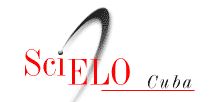Influencia del estrés psicológico y la actividad física moderada en la reactividad cardiovascular
Resumen
Palabras clave
Referencias
Adán A, Sánchez M. Evaluación psicofisiológica del estrés mediante la reactividad cardíaca. Psiq Biol. 2003;10(1):25-32.
Selye H. Forty years of stress research: principal remaining problems and misconceptions. Can Med Assoc J. 1976;115(1):53-6.
Webb HE, Garten RS, McMinn DR, Beckman JL, Kamimori GH, Acevedo EO. Stress hormones and vascular function in firefighters during concurrent challenges. Biol Psychol. 2011;87(1):152-60.
Smeets T. Autonomic and hypothalamic-pituitary-adrenal stress resilience: impact of cardiac vagal tone. Biol Psychol. 2010;84(2):290-5.
Hinton JW, Rotheiler EA, Gemmell M, Shewan D. Heart rate, anxiety, anger, and arousal reactions to enforced time-wasting: dependence on reactive uncontrol, work involvement, and dominance factors of ‘type A.’ Int J Psychophysiol. 1991;11(2):115-24.
Webb HE, Rosalky DS, Tangsilsat SE, McLeod KA, Acevedo EO, Wax B. Aerobic fitness affects cortisol responses to concurrent challenges. Med Sci Sports Exerc. 2013;45(2):379-86.
Alex C, Lindgren M, Shapiro PA, McKinley PS, Brondolo EN, Myers MM, et al. Aerobic exercise and strength training effects on cardiovascular sympathetic function in healthy adults: a randomized controlled trial. Psychosom Med. 2013;75(4):375-81.
Phillips AC. Blunted cardiovascular reactivity relates to depression, obesity, and self-reported health. Biol Psychol. 2011;86(2):106-13.
Phillips AC, Roseboom TJ, Carroll D, de Rooij SR. Cardiovascular and cortisol reactions to acute psychological stress and adiposity: cross-sectional and prospective associations in the Dutch Famine Birth Cohort Study. Psychosom Med. 2012;74(7):699-710.
Allen MT, Stoney CM, Owens JF, Matthews KA. Hemodynamic adjustments to laboratory stress: the influence of gender and personality. Psychosom Med. 1993;55(6):505-17.
Kajantie E, Phillips DIW. The effects of sex and hormonal status on the physiological response to acute psychosocial stress. Psychoneuroendocrinology. 2006;31(2):151-78.
Sandberg K, Ji H. Sex differences in primary hypertension. Biol Sex Differ. 2012;3(1):7.
Pickering TG. The effects of environmental and lifestyle factors on blood pressure and the intermediary role of the sympathetic nervous system. J Hum Hypertens. 1997;11(Suppl. 1):9-18.
Acevedo EO, Dzewaltowski DA, Kubitz KA, Kraemer RR. Effects of a proposed challenge on effort sense and cardiorespiratory responses during exercise. Med Sci Sports Exerc. 1999;31(10):1460-5.
Huang CJ, Franco RL, Evans RK, Mari DC, Acevedo EO. Stress-induced microvascular reactivity in normal-weight and obese individuals. Appl Physiol Nutr Metab. 2014;39(1):47-52.
Szijgyarto IC, King TJ, Ku J, Poitras VJ, Gurd BJ, Pyke KE. The impact of acute mental stress on brachial artery flow-mediated dilation differs when shear stress is elevated by reactive hyperemia versus handgrip exercise. Appl Physiol Nutr Metab. 2013;38(5):498-506.
Mausbach BT, Chattillion E, Roepke SK, Ziegler MG, Milic M, von Känel R, et al. A longitudinal analysis of the relations among stress, depressive symptoms, leisure satisfaction, and endothelial function in caregivers. Health Psychol. 2012;31(4):433-40.
Wagner JA, Tennen, H, Finan PH, White WB, Burg MM, Ghuman N. Lifetime history of depression, type 2 diabetes, and endothelial reactivity to acute stress in postmenopausal women. Int J Behav Med. 2012;19(4):503-11.
Rosati MV, Sancini A, Tomei F, Andreozzi G, Scimitto L, Schifano MP, et al. Plasma cortisol concentrations and lifestyle in a population of outdoor workers. Int J Environ Health Res. 2011;21(1):62-71.
Robinson SJ, Leach J, Owen-Lynch PJ, Sünram-Lea SI. Stress reactivity and cognitive performance in a simulated firefighting emergency. Aviat Space Environ Med. 2013;84(6):592-9.
Ji LL, Gómez MC, Vina J. Exercise and hormesis: activation of cellular antioxidant signaling pathway. Ann NY Acad Sci. 2006;1067(1):425-35.
Huang CJ, Webb HE, Evans RK, McCleod KA, Tangsilsat SE, Kamimori GH, et al. Psychological stress during exercise: immunoendocrine and oxidative responses. Exp Biol Med. 2010;235(12):1498-504.
Wirtz PH, Ehlert U, Emini L, Suter T. Higher body mass index (BMI) is associated with reduced glucocorticoid inhibition of inflammatory cytokine production following acute psychological stress in men. Psychoneuroendocrinology. 2008;33(8):1102-10.
Huang CJ, Webb HE, Garten RS, Kamimori GH, Evans RK, Acevedo EO. Stress hormones and immunological responses to a dual challenge in professional firefighters. Int J Psychophysiol. 2010;75(3):312-18.
Kang DH, Fox C. Th1 and Th2 cytokine responses to academic stress. Res Nurs Health. 2001;24(4):245-57.
Ramey SL, Downing NR, Franke WD, Perkhounkova Y, Alasagheirin MH. Relationships among stress measures, risk factors, and inflammatory biomarkers in law enforcement officers. Biol Res Nurs. 2012;14(1):16-26.
Groer M, Murphy R, Bunnell W, Salomon K, Van Eepoel J, Rankin B, et al. Salivary measures of stress and immunity in police officers engaged in simulated critical incident scenarios. J Occup Environ Med. 2010; 52(6):595-602.
Durand G, Tsismenakis AJ, Jahnke SA, Baur DM, Christophi CA, Kales SN. Firefighters’ physical activity: relation to fitness and cardiovascular disease risk. Med Sci Sports Exerc. 2011;43(9):1752-9.
Nojima H, Watanabe H, Yamane K, Kitahara Y, Sekikawa K, Yamamoto H, et al. Effect of aerobic exercise training on oxidative stress in patients with type 2 diabetes mellitus. Metabolism. 2008;57(2):170-6.
Dod HS, Bhardwaj R, Sajja V, Weidner G, Hobbs GR, Konat GW, et al. Effect of intensive lifestyle changes on endothelial function and on inflammatory markers of atherosclerosis. Am J Cardiol. 2010;105(3):362-7.
Enlaces refback
- No hay ningún enlace refback.
FINLAY EN: 








FINLAY CERTIFICADA POR:

Esta revista "no aplica" cargos por publicación en ninguna etapa del proceso editorial.
Dirección postal: Calle 51A y Avenida 5 de Septiembre Cienfuegos, Cuba Código postal: 55100.
http://www.revfinlay.sld.cu
Telefono: +53 43 516602. Telefax: +53 43 517733.
amgiraldoni@infomed.sld.cu
ISSN: 2221-2434
RNPS: 5129






